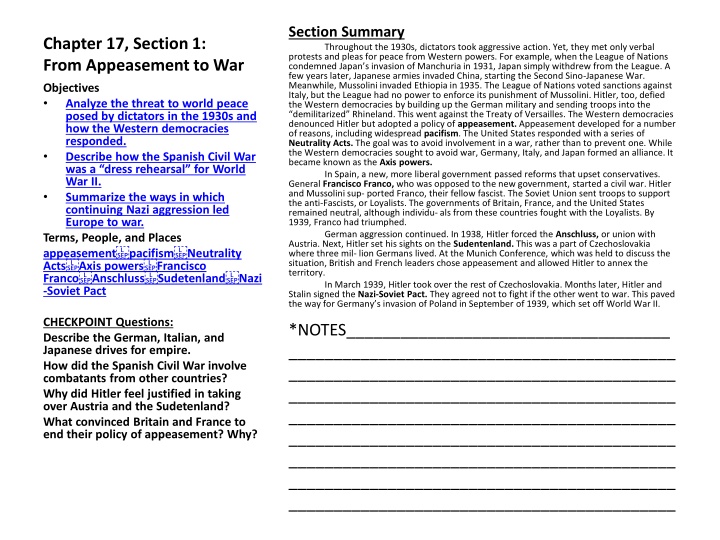Dictator Aggression and the Outbreak of World War II in the 1930s
Throughout the 1930s, dictators such as Hitler, Mussolini, and Japanese leaders took aggressive actions that threatened world peace. Western democracies responded with verbal protests and a policy of appeasement, allowing dictators to expand their empires unchecked. The Spanish Civil War served as a precursor to WWII, with international involvement on both sides. Nazi aggression continued as Germany invaded Poland in 1939, triggering the start of World War II.
Download Presentation

Please find below an Image/Link to download the presentation.
The content on the website is provided AS IS for your information and personal use only. It may not be sold, licensed, or shared on other websites without obtaining consent from the author.If you encounter any issues during the download, it is possible that the publisher has removed the file from their server.
You are allowed to download the files provided on this website for personal or commercial use, subject to the condition that they are used lawfully. All files are the property of their respective owners.
The content on the website is provided AS IS for your information and personal use only. It may not be sold, licensed, or shared on other websites without obtaining consent from the author.
E N D
Presentation Transcript
Section Summary Throughout the 1930s, dictators took aggressive action. Yet, they met only verbal protests and pleas for peace from Western powers. For example, when the League of Nations condemned Japan s invasion of Manchuria in 1931, Japan simply withdrew from the League. A few years later, Japanese armies invaded China, starting the Second Sino-Japanese War. Meanwhile, Mussolini invaded Ethiopia in 1935. The League of Nations voted sanctions against Italy, but the League had no power to enforce its punishment of Mussolini. Hitler, too, defied the Western democracies by building up the German military and sending troops into the demilitarized Rhineland. This went against the Treaty of Versailles. The Western democracies denounced Hitler but adopted a policy of appeasement. Appeasement developed for a number of reasons, including widespread pacifism. The United States responded with a series of Neutrality Acts. The goal was to avoid involvement in a war, rather than to prevent one. While the Western democracies sought to avoid war, Germany, Italy, and Japan formed an alliance. It became known as the Axis powers. In Spain, a new, more liberal government passed reforms that upset conservatives. General Francisco Franco, who was opposed to the new government, started a civil war. Hitler and Mussolini sup- ported Franco, their fellow fascist. The Soviet Union sent troops to support the anti-Fascists, or Loyalists. The governments of Britain, France, and the United States remained neutral, although individu-als from these countries fought with the Loyalists. By 1939, Franco had triumphed. German aggression continued. In 1938, Hitler forced the Anschluss, or union with Austria. Next, Hitler set his sights on the Sudentenland. This was a part of Czechoslovakia where three mil- lion Germans lived. At the Munich Conference, which was held to discuss the situation, British and French leaders chose appeasement and allowed Hitler to annex the territory. In March 1939, Hitler took over the rest of Czechoslovakia. Months later, Hitler and Stalin signed the Nazi-Soviet Pact. They agreed not to fight if the other went to war. This paved the way for Germany s invasion of Poland in September of 1939, which set off World War II. Chapter 17, Section 1: From Appeasement to War Objectives Analyze the threat to world peace posed by dictators in the 1930s and how the Western democracies responded. Describe how the Spanish Civil War was a dress rehearsal for World War II. Summarize the ways in which continuing Nazi aggression led Europe to war. Terms, People, and Places appeasement pacifism Neutrality Acts Axis powers Francisco Franco Anschluss Sudetenland Nazi -Soviet Pact CHECKPOINT Questions: Describe the German, Italian, and Japanese drives for empire. How did the Spanish Civil War involve combatants from other countries? Why did Hitler feel justified in taking over Austria and the Sudetenland? What convinced Britain and France to end their policy of appeasement? Why? *NOTES____________________________________ ___________________________________________ ___________________________________________ ___________________________________________ ___________________________________________ ___________________________________________ ___________________________________________ ___________________________________________ ___________________________________________
Section Summary In September 1939, Nazi forces launched a blitzkrieg against Poland. First the Luftwaffe, the German air force, bombed. Then, tanks and troops pushed their way in. At the same time, Stalin invaded from the east, grabbing land. Within a month, Poland ceased to exist. Then, in early 1940, Hitler conquered Norway, Denmark, the Netherlands, and Belgium. By May, German forces had bypassed France s Maginot Line. British forces that had been sent to help the French were trapped. In a desperate scheme, the British rescued their troops from Dunkirk. However, in June, the French were forced to surrender. Germany occupied northern France and set up a puppet state, the Vichy government, in the south. The British, led by Winston Churchill, remained defiant against Hitler. In response, Hitler launched bombing raids over British cities that lasted from September 1940 until June 1941. Despite this blitz, Hitler was not able to take Britain. Meanwhile, Hitler sent one of his best commanders, General Erwin Rommel, to North Africa. Rom- mel had a string of successes there. In the Balkans, German and Ital- ian forces added Greece and Yugoslavia to the growing Axis territory. At the same time, the Japanese were occupying lands in Asia and the Pacific. In June 1941, Hitler nullified the Nazi-Soviet Pact by invading the Soviet Union. Stalin was unprepared, and the Soviet army suffered great losses. The Germans advanced toward Moscow and Leningrad. During a lengthy siege of Leningrad, more than a million Russians died. The severe Russian winter finally slowed the German army. As they marched across Europe, the Nazis sent millions to concentration camps to work as slave laborers. Even worse, Hitler established death camps to kill those he judged racially inferior. Among many others, some six million Jews were killed in what became known as the Holocaust. The United States declared neutrality at the beginning of the war. Yet many Americans sympathized with those who fought the Axis powers. Congress passed the Lend-Lease Act of 1941, allowing the United States to sell or lend war goods to foes of the Axis. On December 7, 1941, the Japanese bombed the U.S. fleet at Pearl Harbor. Four days later, Congress declared war on Japan. *NOTES____________________________________ ___________________________________________ ___________________________________________ ___________________________________________ ___________________________________________ ___________________________________________ ___________________________________________ ___________________________________________ ___________________________________________ Chapter 17, Section 2: The Axis Advances Objectives Describe how the Axis powers came to control much of Europe, but failed to conquer Britain. Summarize Germany s invasion of the Soviet Union. Understand the horror of the genocide the Nazis committed. Describe the role of the United States before and after joining World War II. Terms, People, and Places blitzkrieg Luftwaffe Vichy General Erwin Rommel concentration camps Holocaust Lend-Lease Act CHECKPOINT Questions: Which regions fell under Axis rule between 1939 and 1941? What caused Hitler s invasion of the Soviet Union to stall? How did Hitler s views about race lead to the murder of six million Jewish people and millions of Slavs, Gypsies, and others? Why did Japanese leaders view the United States as an enemy?
Section Summary To defeat the Axis powers in World War II, the Allies devoted all their resources to the war effort. Governments took a greater role in the economy. For example, governments ordered factories to make tanks instead of cars. Consumer goods were rationed, and wages and prices were regulated. A positive result was that the increase in production ended the Great Depression. However, governments also limited citizens rights, censored the press, and resorted to pro- paganda. At the same time, women, symbolized by Rosie the Riveter, replaced men in factories. Women also played a more direct role in some military operations. The years 1942 and 1943 marked the turning point of the war. In the Pacific, Allied forces won the battles of the Coral Sea and Midway. In both battles, attacks were launched from enormous air- craft carriers. In North Africa, British and American forces, led by General Dwight Eisenhower, soon trapped Rommel s army, and he surrendered in May 1943. With North Africa under their control, the Allies crossed the Mediterranean and landed in Sicily. Allied victo- ries in Italy led to the overthrow of Mussolini, but fighting contin- ued in Italy for another 18 months. On the Eastern front, a key turning point was the Battle of Stalingrad. After a German advance on the city and brutal house-to-house fighting, the Soviet army encircled the German troops. Without food or ammunition, the Germans surrendered. On June 6, 1944, the Allies launched the D-Day invasion of France. Allied troops faced many obstacles, but the Germans finally retreated. As the Allies advanced, Germany reeled from incessant, around-the-clock bombing. A German counterattack, the Battle of the Bulge, resulted in terrible losses on both sides. However, with Germany s defeat seeming inevitable, the Big Three Roosevelt, Churchill, and Stalin met to plan for the end of the war. Key fea- tures of this Yalta Conference were the Soviet agreement to enter the war against Japan and the division of Germany into four zones of occupation. However, growing mistrust at Yalta foreshadowed a split among the Allies. Chapter 17, Section 3: The Allies Turn the Tide Objectives Understand how nations devoted all of their resources to fighting World War II. Explain how Allied victories began to push back the Axis powers. Describe D-Day and the Allied advance toward Germany. Terms, People, and Places Rosie the Riveter aircraft carrier Dwight Eisenhower Stalingrad D- Day Yalta Conference CHECKPOINT Questions: How did the Allies mobilize all of their resources for the war effort? How did the Allies push back the Axis powers on four fronts? What agreements did Churchill, Roosevelt, and Stalin come to at Yalta? *NOTES____________________________________ ___________________________________________ ___________________________________________ ___________________________________________ ___________________________________________ ___________________________________________ ___________________________________________ ___________________________________________ ___________________________________________
Chapter 17, Section 4: Victory in Europe and the Pacific Section Summary In Europe, World War II officially ended on May 8, 1945, or V-E Day. The Allies were able to defeat the Axis powers for many rea- sons. Because of their location, the Axis powers had to fight on sev- eral fronts at the same time. Hitler also made some poor military decisions. For example, he underestimated the Soviet Union s ability to fight. The huge productive capacity of the United States was another factor. At the same time, Allied bombing hindered German production and caused oil to become scarce. This nearly grounded the Luftwaffe. Although Germany was defeated, the Allies still had to defeat the Japanese in the Pacific. By May 1942, the Japanese had gained control of the Philippines, killing thousands during the Bataan Death March. However, after the battles of Midway and the Coral Sea, the United States took the offensive. General Douglas MacArthur began an island-hopping campaign to recapture islands from the Japanese. The captured islands served as stepping- stones to the next objective Japan. The Americans gradually moved north and were able to blockade Japan. Bombers pounded Japanese cities and industries. At the same time, the British pushed Japanese forces back into the jungles of Burma and Malaya. In early 1945, bloody battles on Iwo Jima and Okinawa showed that the Japanese would fight to the death rather than surrender. Some young Japanese became kamikaze pilots who flew their planes purposefully into U.S. ships. While Allied military leaders planned to invade, scientists offered another way to end the war. They had conducted research, code- named the Manhattan Project, that led to the building of an atomic bomb for the United States. The new U.S. president, Harry Truman, decided that dropping the bomb would save American lives. The Allies first issued a warning to the Japanese to surrender or face utter and complete destruction, but the warning was ignored. On August 6, 1945, a U.S. plane dropped an atomic bomb on the city of Hiroshima, instantly killing more than 70,000 people. Many more died from radiation sickness. When the Japanese did not surrender, another bomb was dropped on Nagasaki on August 9. The next day, Japan finally surrendered, ending World War II. Objectives Describe the reasons for the final defeat of the Nazis. Summarize how the Allies began to push back the Japanese in the Pacific. Explain the American strategy for ending the war against Japan and the consequences of that strategy. Terms, People, and Places V-E Day Bataan Death March Douglas MacArthur island- hopping kamikaze Manhattan Project Hiroshima Nagasaki *NOTES____________________________________ ___________________________________________ ___________________________________________ ___________________________________________ ___________________________________________ ___________________________________________ ___________________________________________ ___________________________________________ ___________________________________________ CHECKPOINT Questions: How did the Allied forces finally defeat the Germans? What strategy did General MacArthur use to fight the Japanese in the Pacific? What strategies did the Allies use to end the war with Japan?























